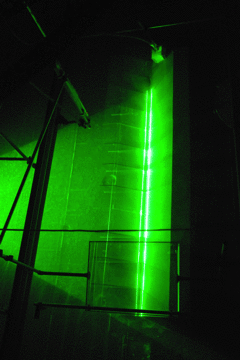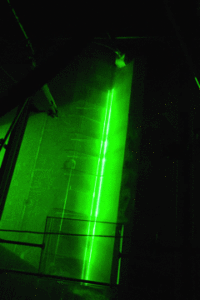
And now on to even more realistic ice shelves!
We have already described experiments where our ice shelf was tilted, making the setup a little more realistic* than before (link here). But then later that day, we did two more experiments! And this time, the ice shelf wasn’t just tilted, it was also not going up all the way to the surface (or, well, it’s flat bottom did not, and then there was a sharp edge and the side of the ice shelf went out of the water). So we are expecting to see a mixture between the experiments shown is yesterday’s blog post: Some of the water being blocked by the ice shelf, but some possibly conserving its potential vorticity and going down the v of the canyon and then turning around and coming back up.
And that’s what we saw!
Can you spot the return flow that has come out from below the ice shelf in the lower layers before it gets obscured by all the stuff that got blocked by the ice shelf in the upper layers?

Nice when experiments really work out the way you expect them to do! :-)
*I have a blogpost in the making on what “realistic” actually means in the context of geophysical fluid dynamics experiments, and if that is even something one should aim for (spoiler alert: not necessarily!), but I keep getting too distracted by all the cool stuff going on here in Grenoble, that it hasn’t progressed out of the draft stage. But I will finish it up and post it, I promise!
